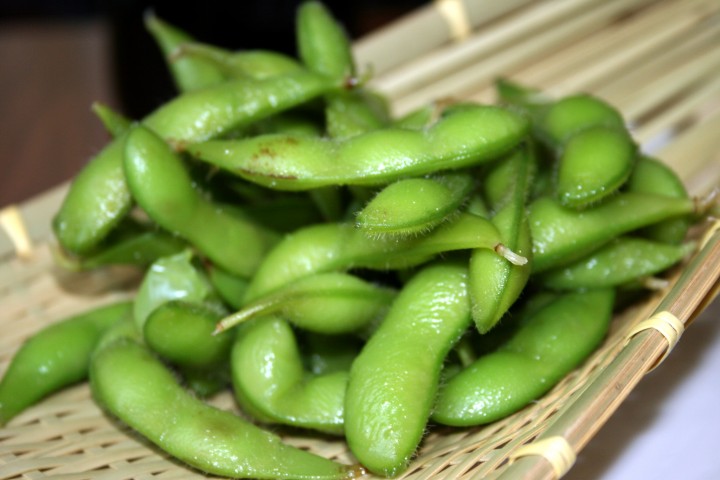
Photo: Zesmerelda | Wikipedia
Mindless snacking is something many of us are guilty of at some time or another. It’s easy to munch through a bag of chips when we feel hungry and are trying to get through our daily tasks. However, we need to think twice whether we are teaching our children the same bad habits. Instead of placing a plate of samosas, French fries or other junk food in front of the kids in an effort to tide them over till dinner, give them a high-protein snack. With very little additional effort it is possible to give them a nutritious boost and teach them healthy food habits for life.
Late afternoon or early evenings are the time when hunger strikes for most children. Their lunch was some time ago and dinner won’t be ready for a another two hours, so they’ll need to refuel. In one study, researchers found that a high-protein afternoon snack, particularly one made from soy foods, reduces unhealthy evening snacking in teenagers, thereby improving their diet and preventing obesity.
“Standard meals tend to go to the wayside for kids this age – particularly from mid-afternoon to late evening – and many of the convenient ‘grab-and-go’ snacks are high in fat and sugar,” said lead researcher Heather Leidy, assistant professor of nutrition and exercise physiology at the University of Missouri.
“When kids eat high-protein snacks in the afternoon, they are less likely to eat unhealthy snacks later in the day, which is particularly important for kids who want to prevent unhealthy weight gain,” Leidy explained.
The study included adolescents between the ages of 13 and 19, both male and female, who were classified as either normal weight or overweight. The researchers were looking to see afternoon snacks affected the teenagers’ appetite and what food choices they made later in the day. They compared the behavior of teens when the did eat a snack and when the teens skipped eating snacks altogether.
“In addition to the appetite and satiety benefits, we found that when the teens ate the high-protein snacks, they incorporated more protein throughout the day and consumed less dietary fat,” Leidy said. “In addition, we also found that the high-protein snacks improved certain aspects of mood and cognitive function.”
Healthy snacking and it improves their mood — sounds to good to be true, right? The study does have some weaknesses, there were only 31 participants which makes it a small sample size, and the duration was only a few days. But even if the benefits are not as great as the authors claim, developing a high protein mindset is beneficial on its own. As another report in June 2015 found, people in India are not getting enough protein in their diets, so a change is called for.
Switching to high protein snacks doesn’t have to be difficult. If you’re broke for ideas, here are a few suggestions.
- Edamame. Yes that’s Japanese but it just means steamed beans. Soybeans, that is. While much of India’s soybeans go towards soybean oil production, it is possible to get beans in the pod. Just boil them in salty water for 3-5 minutes and they’re ready to eat. Since soybeans naturally contain umami, they pack a lot of flavour.
- Tofu. There are many ways to prepare this soybean product that don’t involve frying, but many of them require an oven. Using a nonstick pan and little oil, it’s still possible to fry them up and not make them too fatty. Spice it up to your child’s taste.
- Soy milk. Soy milk is definitely more expensive than regular milk, but it’ll also be consumed less. A one-liter Tetrapak could last up to a week, depending on your child’s appetite. Soy milk comes already flavoured, but if you get the plain one you could add fruits to make a smoothie. You can also make soy milk yogurt.
- Milk! Get the double-toned variety and make a smoothie with fruits, and it’s as wholesome and nutritious ever.
- Eggs. They’re amazingly nutritious. You can boil a weeks worth and keep them in the fridge.
- Mixed nuts. You can buy them pre-packaged or buy the ingredients separately and make your own mix according to your teen’s preferences. You can also throw in raisins or other dried fruits. Almonds and pistachios contain the highest protein.
- Pumpkin seeds. Raw or roasted, they contain 14 grams of protein in a cupful of seeds.
- Peanut butter sandwich. Long a staple snack in the US, peanut butter is now available in India too. Smear some on whole wheat bread and it’s good to go. If your child complains that it’s sticking to the roof of their mouth, and add some sliced bananas, a little honey, or if there’s no helping it, some jam.
- Hummus. This ground-up chick-pea mixture with some sliced carrots or cauliflower make a great combination.
- Chana. You can dry roast it at home or get pre-roasted chana. Adding some chopped onions, tomatoes and capsicum, chillis if your child likes them, and it’s a high-protein chaat!
- Meat. Many Indians are vegetarians, but many are not. If you prepare meat at home, and you have some leftover from last night’s dinner, feed it to your teen! You can also buy many meat products that are designed to be snacks. As for vegetarians, there are soy-based “meats” in the supermarket.
The best thing about most of these is that your teenager can make them him- or herself. Perfect training for when they have to head off to university.
And remember, most of these can also work for your under-ten babies, there is no age limit.
Share your thoughts, leave a comment below. Please like FamiLife’s page on Facebook so that you get all our articles and others may find us.
